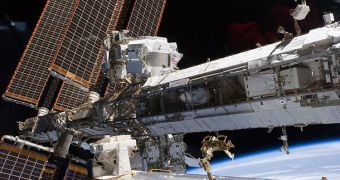Astronauts aboard the International Space Station (ISS) and mission controllers on the ground celebrated the 1-year anniversary of the orbital lab's dark matter experiment, entitled the Alpha Magnetic Spectrometer-2 (AMS-2).
The complex piece of equipment, priced at $2 billion, was launched into space on the second-to-last space shuttle mission, STS-134, conducted by Endeavour. The orbiter took off from Launch Pad 39A at the Kennedy Space Center on May 16, 2011, at 08:56 am EDT (1256 GMT).
Dedicated exclusively to dark matter research, the AMS-2 is the largest, most complex and most expensive experiment ever flown to space. It was affixed to the starboard truss of the ISS on July 19, 2011, during an extravehicular activity (EVA).
To mark the 1-year anniversary, retired NASA astronaut Mark Kelly and former Congresswoman Gabrielle Giffords visited a European lab that was heavily involved in the project. This is the first time Giffords travels abroad after receiving a gunshot wound to the head in a mass shooting last year.
Kelly was in orbit aboard Endeavour when the incident occurred. This is why he decided to conduct this visit to CERN in Geneva, Switzerland, together with his wife. They received a tour from officials at the advanced European science facility.
Joining Kelly and Giffords at CERN were STS-134 Pilot Gregory H. Johnson and mission specialists Michael Fincke, Greg Chamitoff, Andrew Feustel, (NASA) and Roberto Vittori (European Space Agency).
AMS-2 works by surveying the amount of cosmic ray particles that strike its sensitive detectors. This enables it to provide scientists with more data on the nature of the Universe's most energetic particles.
Dark matter and antimatter are the preferred goals of scientists operating with data from this experiment. The reason why it was installed on the ISS is that Earth's atmosphere blocks out most cosmic rays, making ground-based observations nearly impossible.
“The AMS detector has so far achieved everything we expected of it. That's a great credit to the team that put the detector together, and the team that installed it on the ISS,” explains the principal investigator of the experiment, Nobel laureate Samuel Ting.
“We're honored to have them here today to celebrate AMS's first year in space,” he adds in a statement quoted by Space.
“Among AMS's achievements is that for the first time, we've been able to identify electrons with energies exceeding 1 TeV before they enter the atmosphere. This holds out great promise for the AMS research program that's now getting underway,” Ting explains.

 14 DAY TRIAL //
14 DAY TRIAL //